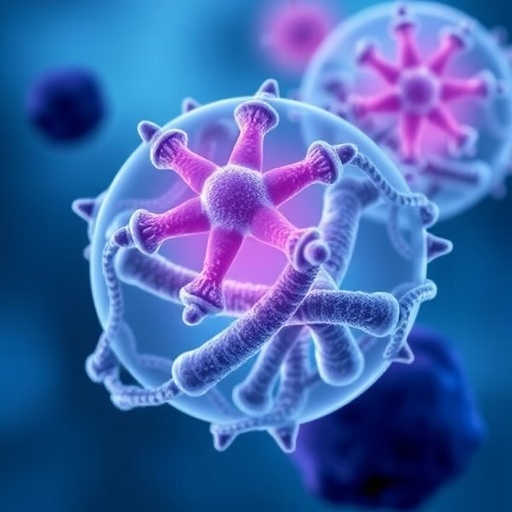In the intricate landscape of early pregnancy, the placenta embarks on a remarkable metamorphosis that is critical to fetal development and maternal health. This vital organ, forming at the maternal-fetal interface, transforms from discrete cellular units into a fused, syncytial layer that efficiently mediates nutrient and gas exchange while modulating the maternal immune response. Despite its significance, the molecular choreography underlying this transformation has remained elusive—until now. Groundbreaking research from Scripps Research has illuminated a pivotal mechanistic player in placental formation: the glycan-binding protein galectin-3, which orchestrates the fusion of placental cells by interacting with unique sugar-modified surface proteins.
During the earliest stages of gestation, placental cells, initially separate entities each encapsulated by distinct membranes and nuclei, undergo syncytialization—a process where individual cells merge to create a multinucleated syncytium. This fused cellular architecture is indispensable for the placenta’s role as a selective barrier and conduit. Failure in this fusion process is closely associated with severe pregnancy complications including preeclampsia and intrauterine growth restriction, underscoring the necessity of dissecting its molecular underpinnings.
At the heart of this process lies galectin-3, a protein renowned for its affinity to specific carbohydrate motifs present on cell surface glycoproteins. Unlike typical protein interaction factors, galectin-3 binds glycans—complex sugar chains covalently attached to proteins—a form of post-translational modification that bestows additional regulatory layers to cell communication and adhesion. Though elevated galectin-3 levels have been observed in abnormal pregnancies, its precise role within the placental microenvironment had not been concretely defined until the contributions from Huang’s laboratory.
Utilizing a sophisticated biochemical innovation called proximity labeling, the research team developed a molecular tagging system that allows them to capture fleeting and spatially restricted interactions between galectin-3 and its glycoprotein counterparts. This method entails the employment of a chemically modified galectin-3, which, upon binding its glycosylated targets, catalyzes the covalent labeling of neighboring proteins. This ‘molecular spray paint’ effectively freezes transient encounters, enabling their identification through subsequent proteomic analyses.
Applying proximity labeling to human placental cell cultures, the researchers uncovered that galectin-3 preferentially interacts with two critical glycoproteins: CD9 and integrin beta 1 (ITGB1). Both proteins are integral membrane components implicated in cell adhesion and signaling pathways. Crucially, gene knockout experiments revealed that ablating either CD9 or ITGB1 crippled the ability of placental cells to undergo fusion, pinpointing these molecules as essential co-receptors in the syncytialization machinery.
A striking revelation came with the identification of an atypical glycosylation site on CD9—an unconventional sugar modification scarcely documented in mammalian biology. This rare glycosylation appears to serve as a specialized docking station for galectin-3, emphasizing the nuanced and specific nature of glycan-mediated cellular interactions. Such discoveries challenge prevailing notions that glycosylation is a uniform or fully predictable modification, highlighting the complexity and individuality of cell surface landscapes.
Further mechanistic studies demonstrated that galectin-3’s capacity to cluster is indispensable for its function in promoting cell fusion. Engineered forms of galectin-3 incapable of oligomerization failed to induce syncytium formation, suggesting that multi-valent crosslinking of glycoproteins at the cell surface aggregates cellular membranes sufficiently to drive their fusion over a time course of approximately 48 hours. This molecular scaffolding imposed by galectin-3 likely stabilizes membrane contacts and triggers signaling cascades requisite for syncytialization.
These insights collectively enhance the understanding of placental morphogenesis by illustrating how precise protein-glycan interactions regulate complex cellular behaviors. They also open avenues for therapeutic exploration; modulation of galectin-3 activity could become a strategic target to mitigate pregnancy complications rooted in placental dysfunction. This paradigm not only deepens fundamental biological knowledge but also signals translational potential with significant clinical impact.
The study marks a technological and conceptual advance in glycobiology and reproductive science. Proximity labeling has proven to be a formidable tool for unveiling hidden molecular dialogues that orchestrate cell fate and tissue architecture. The success with placental cells lays the groundwork for applying this technique across diverse biological systems where protein-sugar recognition influences developmental and pathological processes.
Moving forward, the research team aims to verify these findings in vivo within the human placenta, a step critical to validating the physiological relevance of their in vitro cell culture observations. Such confirmation will be pivotal for harnessing galectin-3-centric interventions and for expanding proposed models of membrane fusion events beyond the placenta to other biological contexts involving cell fusion, such as muscle development and immune responses.
The interplay between glycosylation patterns and protein binding specificities remains an exciting frontier. As more is unraveled about the precise sugar modifications and their spatial configurations, new regulatory mechanisms governing cell adhesion, migration, and communication are expected to emerge. These discoveries promise to revolutionize the conceptual framework of cellular interactions and aid in the design of sugar-targeted drugs or diagnostics.
This landmark research underscores the power of integrating chemical biology techniques with cell and developmental biology to solve complex physiological puzzles. Not only does it elucidate a critical step in placental biology, but it also exemplifies how cutting-edge methodologies can drive scientific innovation with profound implications for human health and disease.
Subject of Research: Placental development and molecular mechanisms of syncytialization focused on the role of glycan-binding protein galectin-3.
Article Title: Mapping the placental galectin-3 interactome identifies CD9 and ITGB1 as functional glycoprotein counterreceptors during syncytialization
News Publication Date: November 4, 2025
Web References:
– Proceedings of the National Academy of Sciences: https://www.pnas.org/doi/10.1073/pnas.2511042122
– Scripps Research – Mia Huang: https://www.scripps.edu/faculty/huang/
References:
– Reeves, A. et al. (2025). Mapping the placental galectin-3 interactome identifies CD9 and ITGB1 as functional glycoprotein counter-receptors during syncytialization. Proceedings of the National Academy of Sciences.
Image Credits: Scripps Research
Keywords: Developmental biology, placenta, galectin-3, glycosylation, syncytialization, protein-sugar interactions, proximity labeling, CD9, integrin beta 1, cell fusion, pregnancy complications, placental biology
Tags: carbohydrate motifs in cell interactionsearly gestation placental developmentglycan-binding proteins in pregnancymaternal immune response modulation by placentamaternal-fetal interface dynamicsnutrient exchange in placentaplacental cell fusion and healthplacental formation mechanismspregnancy complications related to placentationresearch breakthroughs in reproductive biologyrole of galectin-3 in fetal developmentsyncytialization process in placenta





